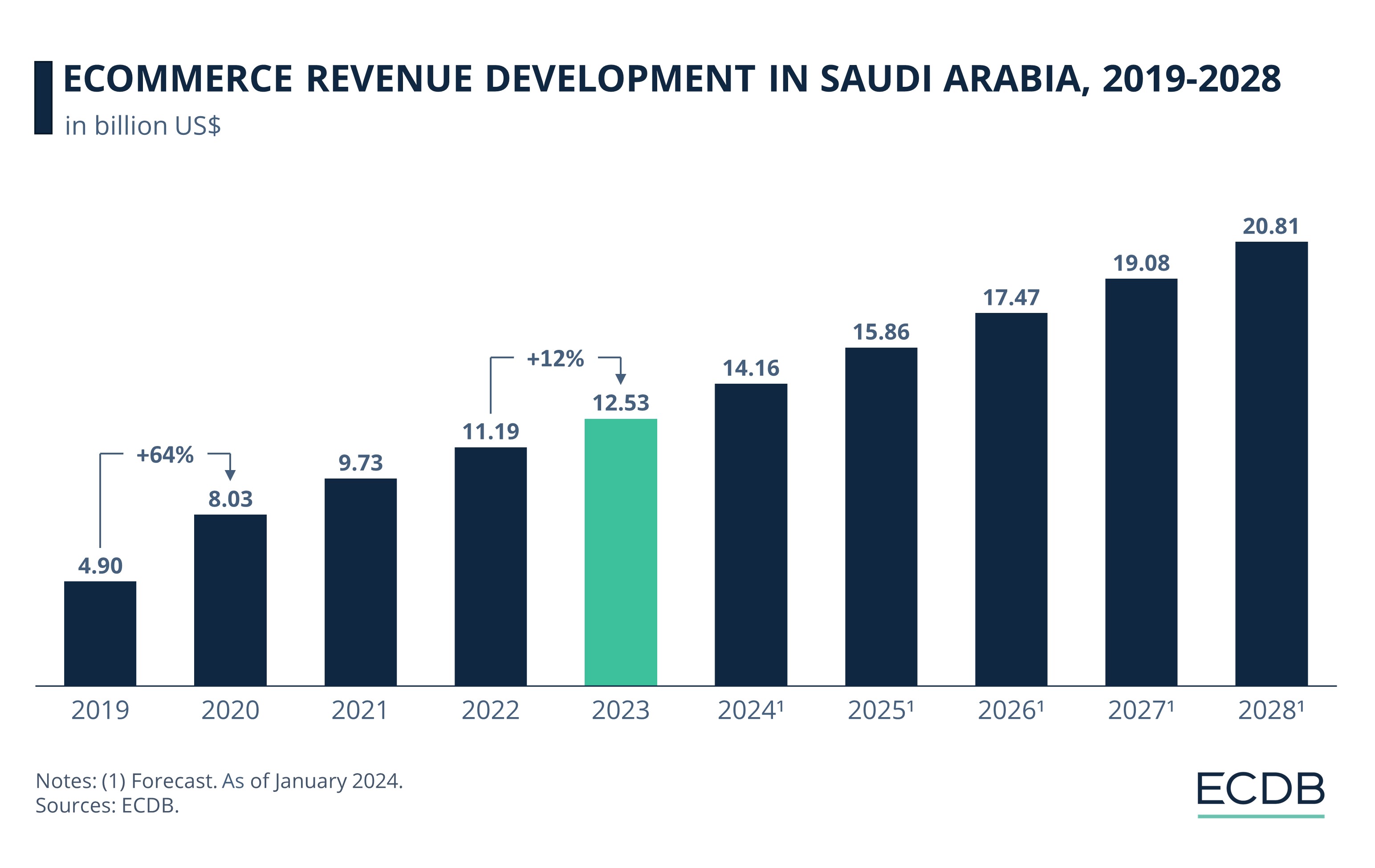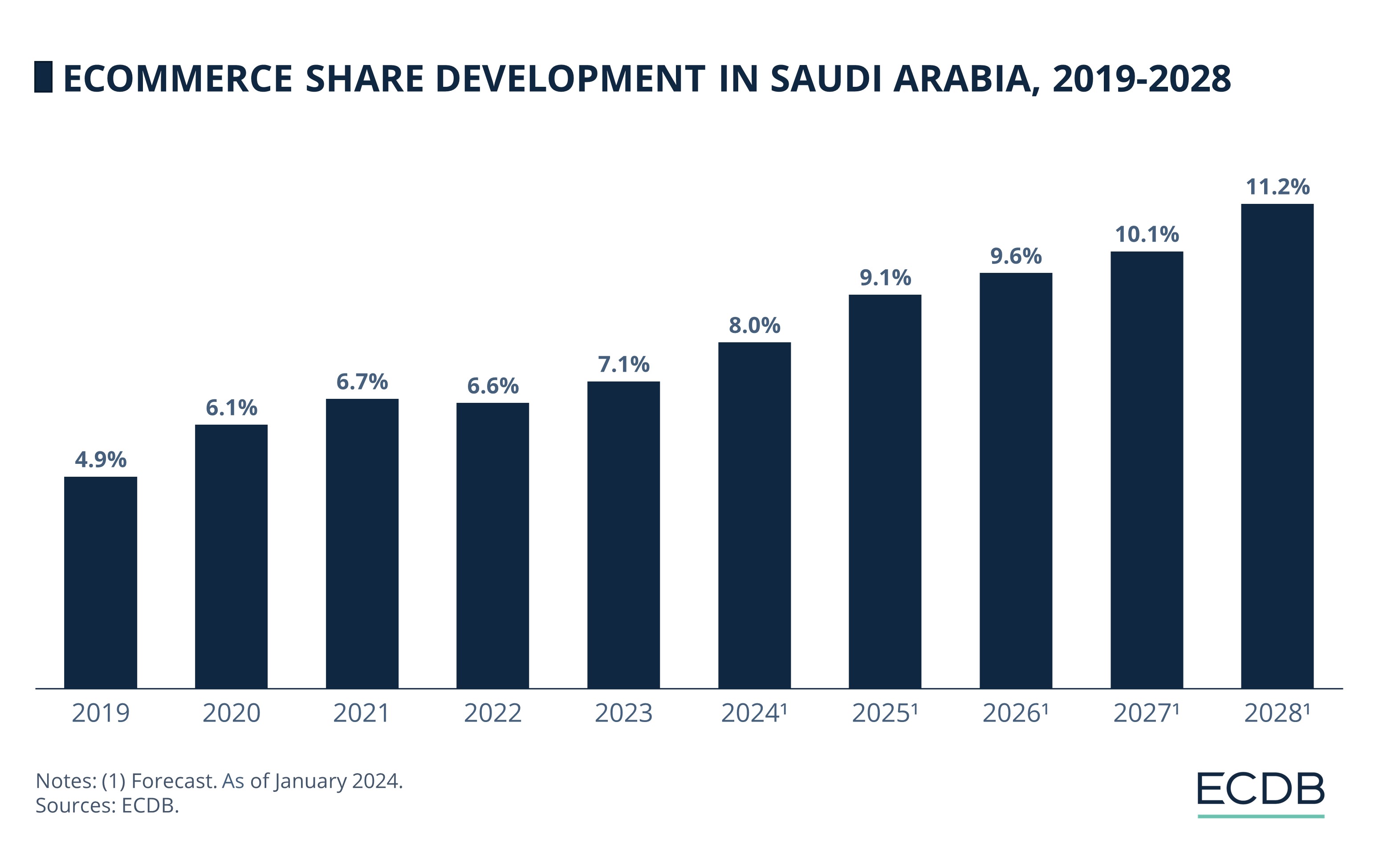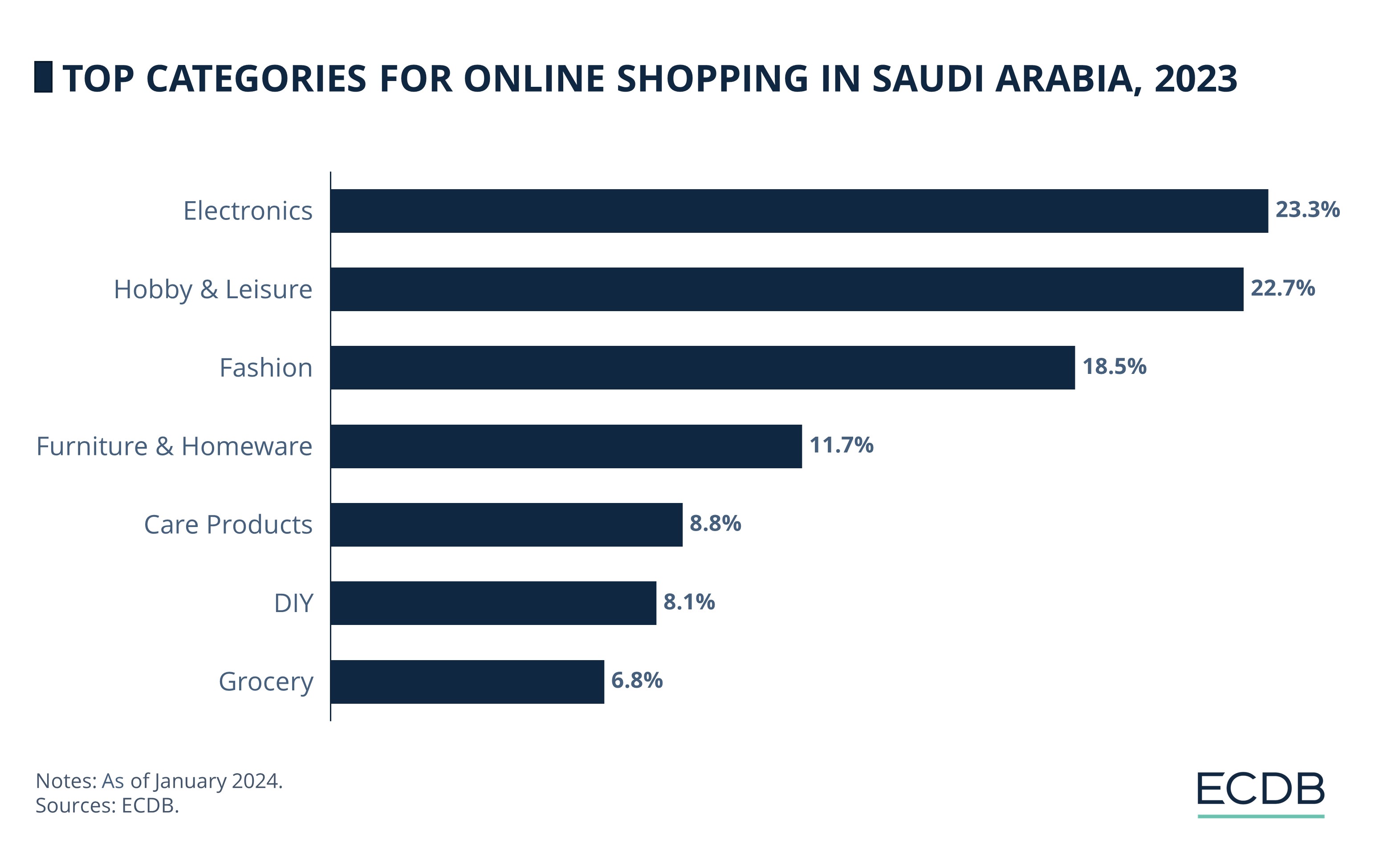eCommerce: Saudi Arabia
eCommerce in Saudi Arabia: Market Development and Top Categories
High internet penetration, digital adoption, and government support boost Saudi Arabia’s online market. ECDB data reveals the country’s eCommerce market development and top categories.
April 10, 2024
Saudi Arabia eCommerce: Key Insights
eCommerce Revenue Growth: Saudi Arabia’s eCommerce revenue in 2023 was US$12.5 billion. Revenue is anticipated to grow at a CAGR (2024-2028) of 10.1% and reach US$21 billion by 2028.
eCommerce Share in Sales: Online sales accounted for 7% of Saudi Arabia’s total retail sales in 2023. The eCommerce sales share is expected to increase to 11% by 2028.
Top Categories: Electronics is the leading product category bought online in Saudi Arabia, followed closely by Hobby & Leisure. Fashion was third, as of 2023.
Saudi Arabia is the 29th largest market for eCommerce worldwide. A look at its eCommerce development shows that revenue from online sales is rising steadily, alongside the online share in total retail sales.
How has Saudi Arabia’s eCommerce revenue developed? Which factors drive its growth in the country? And what are the top product categories in terms of online sales?
Saudi Arabia’s eCommerce Market to Hit US$21 Billion by 2028
Increasing adoption of internet-based services and awareness of online shopping are some of the leading factors driving the expansion of eCommerce in Saudi Arabia.
In 2023, revenues from eCommerce stood at US$12.5 billion, recording year-on-year growth of 12%.

Per ECDB data, the largest leap in Saudi Arabia’s eCommerce sales occurred in 2020, when revenues increased by 64% compared to the previous year. This development aligns with the global trend of eCommerce acceleration seen during the pandemic.
By 2021, yearly growth evened out to 21% before settling at 15% in 2022. In the following years, the market expansion is expected to take place at a comparable rate.
The growth analysis shows that Saudi Arabia’s eCommerce market is expanding at a slow but steady pace. A similar pattern is observed for the country’s eCommerce share in total retail sales.
eCommerce Share: 7% of Saudi Arabia’s Retail Sales Generated Online in 2023
Like Saudi Arabia’s eCommerce revenue, the share of online sales to total retail sales in the country has also been climbing in the past years.
In 2023, online sales made up 7% of the total retail sales generated in Saudi Arabia. This growth in online sales share came after a decline seen in 2022.

The eCommerce share in Saudi Arabia also saw the biggest jump in 2020, when it made up 6.1% the total retail sales from just 4.9% in 2019.
Growth occurred in 2021 as well, before a decline was observed in 2022. But this downturn was small and reversed in the following year, suggesting that the shift to online shopping was more durable than just a pandemic-induced surge.
Projections anticipate the share of eCommerce sales in Saudi Arabia to increase steadily in the upcoming years.
Government Policy for Digital Transformation

The pandemic boosted eCommerce activity in Saudi Arabia, as it did worldwide. High rates of internet penetration helped drive the country’s eCommerce penetration rate. In addition, the growth of the online market – in terms of both revenue and sales share – is also shaped by the government’s long-term strategy to promote eCommerce.
Saudi Arabia’s Vision 2030 document singled out eCommerce as a key focus area in as far back as 2016. Plans to invest in the digital economy included improving online payment services, expanding the logistics network beyond major cities, and fostering the growth of SMEs (small and medium-sized enterprises) to make local eCommerce stores competitive with cross-border platforms.
In 2019, the government also introduced regulations under its eCommerce Law to curb fraud and cybercrime by online businesses, thus enhancing consumer trust in online shopping.
A recent report reflects the impact of this consolidated strategy. Per its findings, Saudi consumers, who familiarized themselves with eCommerce during the pandemic, have now embraced it. Today, they also demonstrate a preference for buying local: 74% of respondents said they expect to increase their purchases from homegrown eCommerce platforms over cross-border marketplaces or stores from the U.S., China, other Gulf countries, or Europe.
Moreover, findings by McKinsey also underscore rising digital adoption among Saudi consumers, who are mobile-first, purchase from online marketplaces, and plan to increase their use of digital channels to engage with various industries, including apparel and other retail product categories.
Top Online Product Categories 2023: Electronics Leads, Hobby & Leisure Second
ECDB data shows that currently, Electronics is the best-selling online product category in Saudi Arabia: it accounted for nearly a quarter (23.3%) of total eCommerce sales in 2023.

Hobby & Leisure was a close second, making up 22.7% of the country’s online revenue, while Fashion ranked third at 18.5%.
In 2023, Grocery was the bottom-ranked category: it accounted for only 6.8% of total online sales. Its performance is also in line with McKinsey’s findings, which discovered that currently, grocery is one of the least digitally disrupted industries in Saudi Arabia. In other words, Saudi consumers still prefer the in-person experience for grocery shopping, with the turn to digital channels relatively low compared to other industries.
However, ECDB data indicates a future shift. By 2028, the share of Grocery is projected to increase by nearly four percentage points to make up 10.8% of Saudi Arabian eCommerce sales, which would place it ahead of Care Products and DIY.
Saudi Arabia eCommerce: Closing Remarks
ECDB data on Saudi Arabia’s eCommerce market indicates that the country is set for sustained growth. Market growth – in terms of eCommerce revenue, online share, and top product categories – comes from rising digital adoption among consumers in various industries.
State policy towards strengthening the regulatory environment for eCommerce and supporting domestic platforms will shape the market dynamics going forward, with international players likely to face more challenge from local brands.
Related insights
Article
Most Valuable Global eCommerce Companies 2024
Most Valuable Global eCommerce Companies 2024
Article
TikTok Ban in the United States: How Will This Impact Social Commerce?
TikTok Ban in the United States: How Will This Impact Social Commerce?
Article
Online Consumer Electronics Market in the United States: Top Players & Market Development
Online Consumer Electronics Market in the United States: Top Players & Market Development
Article
Cross-Border eCommerce in China: GMV Growth, Leading Markets, Top Companies
Cross-Border eCommerce in China: GMV Growth, Leading Markets, Top Companies
Article
Reverse Logistics: Fraudulent Returns in the United States, Industry Trends
Reverse Logistics: Fraudulent Returns in the United States, Industry Trends
Back to main topics